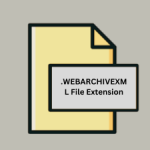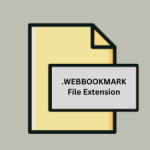.OGNC File Extension

What is an OGNC file?
Files with the .OGNC extension are used for dynamic web pages that are created and processed by server-side scripting languages. These files often contain code that generates HTML, CSS, and JavaScript content dynamically based on user interactions or other parameters.
More Information.
While not widely documented, the initial purpose of the .OGNC file format would be to handle dynamic web content generation. This means the file format is used to create web pages that adapt to user inputs, database queries, or other dynamic data.
Origin Of This File.
The .OGNC file format is not widely recognized or standard, so it might be specific to a particular web development framework or content management system. It’s possible that it was created for proprietary or specialized software within a specific organization or development environment.
File Structure Technical Specification.
- Structure: Typically,
.OGNCfiles might contain a mix of HTML, CSS, JavaScript, and server-side script code (such as PHP, ASP.NET, or Python). The exact structure would depend on the specific framework or software that uses this file type. - Technical Specification: Without a standard specification, the exact technical details would vary. Generally, dynamic web page files are parsed and executed by a web server to generate HTML content that is sent to the client’s browser.
How to Convert the File?
Windows
- Identify the Content:
- Open the
.OGNCfile in a text editor like Notepad++ or Sublime Text to understand its structure and content.
- Open the
- Conversion Tools:
- Manual Conversion: If the file contains code (e.g., HTML, CSS, JavaScript), you can manually convert or rewrite it in a more common format.
- Scripting: Write a script in a language like Python or PowerShell to parse and convert the file content if the format is understood.
- Web Server Setup:
- If the file is used in a web context, you may need to set up a local web server environment (e.g., XAMPP, WAMP) to process and generate HTML from the
.OGNCfile.
- If the file is used in a web context, you may need to set up a local web server environment (e.g., XAMPP, WAMP) to process and generate HTML from the
Linux
- Identify the Content:
- Use a text editor like Vim, Nano, or Gedit to view the file and determine its contents.
- Conversion Tools:
- Manual Conversion: Similar to Windows, if the file contains script code, manually rewrite or convert the content to a standard format.
- Scripting: Utilize scripting languages like Python or Bash to automate the conversion if necessary.
- Web Server Setup:
- Use a web server like Apache or Nginx to process dynamic content and view the results.
Mac
- Identify the Content:
- Open the file in a text editor such as TextEdit, Sublime Text, or Atom to understand its structure.
- Conversion Tools:
- Manual Conversion: Convert the content to standard formats if needed.
- Scripting: Write or use existing scripts in Python or other languages for automated conversion.
- Web Server Setup:
- Install a local server environment like MAMP to handle and view dynamic content.
Android
- Identify the Content:
- Use a text editor app like QuickEdit or AIDE to open and inspect the file.
- Conversion Tools:
- Manual Conversion: Edit and convert the file content manually if feasible.
- Apps and Scripts: Limited options for automated conversion on Android, but you may find apps or scripts that can help.
- Web Server Setup:
- Consider using a local server app like KSWEB or BitWeb Server to process dynamic content if needed.
iOS
- Identify the Content:
- Use text editing apps like Textastic or Koder to view the file’s contents.
- Conversion Tools:
- Manual Conversion: Manually convert the content if possible.
- Apps: Limited support for automated conversion; apps may provide basic editing capabilities.
- Web Server Setup:
- Local web server options are limited on iOS, so you may need to use a remote server or cloud service for processing dynamic content.
Others
- Identify the Content:
- Use available text editors or tools to open and examine the
.OGNCfile.
- Use available text editors or tools to open and examine the
- Conversion Tools:
- Manual Conversion: Edit and convert the file to a more common format if you understand its content.
- Specialized Software: Depending on the platform, specialized tools or software related to the file’s origin may be necessary.
- Web Server Setup:
- For dynamic content, setting up a local or remote web server that can process the file format may be required.
Advantages And Disadvantages.
- Advantages:
- Dynamic Content: Allows for the creation of web pages that change based on user interaction or other factors.
- Customization: Can be tailored to specific needs and integrated with various backend systems.
- Disadvantages:
- Compatibility: May not be supported universally, limiting the ability to share or use the files across different platforms.
- Complexity: Managing and debugging dynamic web pages can be more complex compared to static HTML files.
How to Open OGNC?
Open In Windows
- Use a text editor like Notepad++ or Sublime Text to view and edit the content.
- For dynamic content, you might need a web server environment like XAMPP or WAMP to process and view the file.
Open In Linux
- Use text editors such as Vim, Nano, or Gedit to view and edit.
- A web server setup like Apache or Nginx can be used to process and view dynamic content.
Open In MAC
- Use text editors such as TextEdit or Sublime Text.
- Set up a local server environment using MAMP to process dynamic content.
Open In Android
- Use a text editor app like QuickEdit or AIDE for viewing and editing.
- To process dynamic content, a local server app or a web hosting service may be required.
Open In IOS
- Use text editing apps such as Textastic or Koder.
- Processing dynamic content typically requires a web server environment, which may not be directly available on iOS.
Open in Others
If the file is meant to be used in a specific application or development environment, consult the documentation or support resources for that environment for instructions on how to handle .OGNC files.













